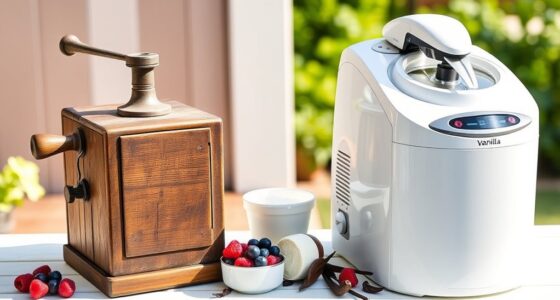To make tart and creamy frozen yogurt at home, start with whole milk Greek yogurt and sweeten it with honey or sugar. Add flavorings like vanilla extract and mix in fresh or frozen fruits. Use an ice cream maker for a smooth texture, or stir the mixture every 30 minutes if you’re doing it by hand. For extra creaminess, consider adding heavy cream. Keep going to discover fun flavor variations and serving ideas!
Key Takeaways
- Start with whole milk Greek yogurt as the base for a rich and creamy texture in your frozen yogurt.
- Sweeten the mixture with honey and sugar to balance the tartness of the yogurt.
- Enhance flavors using vanilla extract or add fresh fruits for natural sweetness and delicious taste.
- If using a no-churn method, stir the mixture every 30 minutes while freezing to prevent ice crystals.
- Store frozen yogurt in airtight containers for up to two months for optimal taste and texture.
Essential Ingredients for Homemade Frozen Yogurt

When you decide to make homemade frozen yogurt, having the right ingredients is essential for achieving that perfect creamy texture and flavor.
Start with whole milk Greek yogurt, as it provides a rich and creamy base. Sweeteners like honey and sugar help balance the tartness of the yogurt. For flavor, vanilla extract is a classic choice, but feel free to experiment with other extracts or citrus juices.
Adding fresh or frozen fruits not only enhances flavor but also adds natural sweetness. If you want a creamier consistency, consider using a bit of heavy whipping cream or corn syrup as a thickener. Additionally, you can incorporate chocolate peanut butter bars for a delightful twist on your frozen yogurt.
These ingredients form the foundation for a delicious frozen treat you can customize to your liking!
Equipment You’ll Need

To make delicious frozen yogurt at home, you’ll need some specific equipment to guarantee the best results. An automatic ice cream maker, like the Cuisinart model, is ideal for achieving a smooth texture in about 20 minutes due to its mixing paddle. If you don’t have one, a blender or whisk is handy for mixing your yogurt base. You’ll also need mixing bowls for combining ingredients and freezer containers to store your frozen yogurt.
For those opting for no-churn methods, shallow freezer pans work well for freezing and stirring your mixture. Remember to keep your equipment clean and follow manufacturer guidelines to assure everything runs smoothly.
With the right tools, you’ll be well on your way to homemade frozen yogurt perfection!
Methods for Achieving Creaminess

Achieving a creamy texture in homemade frozen yogurt hinges on the right ingredients and techniques. Start with whole milk Greek yogurt for a thicker base. To enhance richness, consider adding heavy cream. Whole milk yogurt and corn syrup play essential roles; they prevent ice crystal formation while maintaining sweetness. Additionally, incorporating chia seeds into your frozen yogurt can increase fiber content and promote satiety, making it a nutritious treat. Blend your ingredients until smooth for even creaminess throughout.
For churning, using an ice cream maker is ideal, as it incorporates air and breaks down ice crystals. If you don’t have one, stir the mixture every 30 minutes while it freezes. Finally, store your yogurt in airtight containers to maintain its creamy texture and freshness. With these methods, you’ll enjoy a delightfully creamy homemade frozen yogurt every time!
Popular Flavor Variations

Exploring popular flavor variations can elevate your homemade frozen yogurt experience. For a fruity twist, try gourmet options like Raspberry Tart or Pina Colada, blending vibrant tastes with creamy textures. If you prefer something lighter, invigorating sorbets like Pink Lemonade or Mango are perfect for warm days. Don’t overlook nutty delights like Old Fashioned Peanut Butter yogurt for a smooth treat. For a bold flavor adventure, consider spicy options like Fire Ball or Dune Spice. Seasonal flavors also shine, with Pumpkin Pie in the fall and Watermelon Sorbet in the summer; Watermelon Sorbet offers a nostalgic summer treat with its sour then sweet flavor profile. You can even get creative with combinations, like Nutella with fresh strawberries or salted caramel topped with crunchy pecans, to make your froyo truly unique!
Step-by-Step Instructions for Making Frozen Yogurt

Making your own frozen yogurt at home can be a fun and rewarding experience. Start by mixing Greek or regular yogurt with your choice of sweeteners like sugar or honey, and add any flavorings like vanilla or lemon. Blend until smooth, ensuring the sugar dissolves completely. Straining the yogurt before mixing can enhance your frozen yogurt’s creamy texture.
If you have an ice cream maker, pour the mixture in and churn according to the manufacturer’s instructions. If not, use a food processor, stirring every 30 minutes for 2-6 hours until it reaches your desired consistency. To prevent ice crystals, consider adding corn syrup and stir regularly.
Once ready, let it sit at room temperature briefly for easier scooping. Enjoy your homemade frozen yogurt!
Storage and Shelf Life Tips

To keep your homemade frozen yogurt fresh and enjoyable, it’s crucial to store it properly. You can freeze it in its original container, but using airtight, freezer-safe containers is better to prevent expansion issues. Additionally, freezing yogurt helps reduce food waste and extends its shelf life, making it a convenient option for your recipes. For portion control, try freezing yogurt in ice cube trays and then transferring the cubes to freezer bags, ensuring you remove air to avoid freezer burn. Typically, frozen yogurt lasts up to two months for the best taste and texture, while Greek yogurt may start to deteriorate after 2-3 months. Always label and date your containers, and remember to thaw yogurt in the fridge overnight instead of at room temperature. This way, you’ll maintain its quality and safety for your next tasty treat!
Health and Nutrition Considerations

While indulging in homemade frozen yogurt, it’s essential to contemplate its health and nutritional aspects. This delightful treat boasts probiotics that support gut health and immune function, while also being a good source of calcium for strong bones. Additionally, frozen yogurt is typically made with milk instead of cream, which helps to lower its fat content compared to traditional ice cream. Health-conscious consumers often prefer frozen yogurt due to its lower calorie count and fat content. However, be mindful of the sugar content, which can reach 17 grams per serving. To make healthier choices, consider using plain Greek yogurt to boost protein and reduce sugar, or add fresh fruits for extra nutrients. Opting for natural sweeteners like honey can also enhance flavor without the downsides of refined sugars.
Enjoy your deliciously nutritious dessert!
Troubleshooting Common Issues

Troubleshooting common issues with homemade frozen yogurt can be straightforward if you know what to look for.
If you notice ice crystals, try using denser yogurts like Greek or Turkish to minimize their size. Higher total solids can also help reduce the formation of ice crystals by providing a creamier texture.
Insufficient air incorporation can lead to a dense texture, so agitate your mixture while it freezes.
A watery texture? Strain the yogurt or add cream to improve it.
If the yogurt is too tart, adjust the sugar-to-yogurt ratio.
For texture problems, verify your ice cream maker is pre-chilled and properly set up.
Remember, consistent temperatures during incubation and churning are key; keep an eye on those!
With these tips, you’ll easily resolve most common issues and enjoy creamy frozen yogurt.
Creative Serving Suggestions

When you’re ready to serve your homemade frozen yogurt, think outside the bowl to elevate the experience. Try unique toppings like frozen mixed berries, homemade rhubarb compote, or sliced bananas rolled in coconut. For a flavor boost, infuse your yogurt with fresh fruit, or experiment with mango lassi or raspberry Campari variations. Additionally, consider making Frozen Greek Yogurt Bites as a fun and healthy alternative to traditional desserts. Bring international flair by adding cardamom for an Indian twist or infusing summer vibes with orange creamsicle flavors. Global flavors can truly enhance your frozen yogurt experience! Don’t forget the garnishes! Chopped nuts, chocolate shavings, or caramelized pineapple can enhance texture and taste. For a fun presentation, serve in cones, create a sundae bar, or layer yogurt with granola for a parfait. Your homemade frozen yogurt deserves a creative showcase!
Frequently Asked Questions
Can I Use Non-Dairy Yogurt for Frozen Yogurt?
Yes, you can definitely use non-dairy yogurt for frozen yogurt! In fact, it’s a great option if you’re looking for a dairy-free treat.
Just choose a thick and creamy non-dairy yogurt, like full-fat coconut or soy yogurt, to guarantee a smooth texture.
Sweeten it with natural options like maple syrup, and feel free to add flavors like vanilla or fruit.
With the right balance, you’ll enjoy a delicious frozen dessert!
How Can I Make Frozen Yogurt Without an Ice Cream Maker?
You can definitely make frozen yogurt without an ice cream maker!
Start by mixing Greek yogurt, sweeteners, and any flavorings you like in a bowl or food processor until smooth.
Transfer the mixture to a freezer-safe container and freeze it.
Every 30 minutes, stir the mixture to prevent ice crystals and promote creaminess.
After a few hours, you’ll have delicious frozen yogurt ready to enjoy.
Don’t forget to experiment with your favorite toppings!
What Sweeteners Can I Use Besides Sugar and Honey?
When life gives you lemons, sweeten them wisely!
Instead of sugar or honey, you can use allulose for a smooth texture, monk fruit sweetener for a low-carb option, or pure maple syrup for a rich flavor.
Consider date sugar or coconut sugar if you want something more natural.
If you’re aiming for a vegan choice, agave nectar or stevia works great too.
Experiment with these alternatives for delightful results!
How Do I Prevent My Frozen Yogurt From Becoming Too Hard?
To prevent your frozen yogurt from becoming too hard, consider adding sugar or sweeteners, which lower the freezing point.
Use full-fat yogurt for creaminess, and strain it to remove excess liquid. Incorporating a small amount of alcohol can also help.
Make sure to churn the mixture while freezing to achieve a smooth texture.
Finally, store it in airtight containers and consume it within a week for the best results.
Can I Add Mix-Ins Like Nuts or Chocolate Chips?
Imagine your frozen yogurt as a canvas, ready for a splash of color and texture.
Yes, you can definitely add mix-ins like nuts or chocolate chips! Just freeze them beforehand to keep them from getting soggy.
When you fold them in, you’ll create delightful bites of crunch and sweetness.
Experiment with different combinations to find your favorite mix.
It’s all about balancing flavors and textures for that perfect treat you’ll crave again!
Conclusion
Now that you’ve mastered the art of homemade frozen yogurt, imagine scooping into a bowl of velvety tartness, the sun warming your skin as each creamy bite dances on your tongue. With endless flavor possibilities, your kitchen transforms into a delightful haven of sweet creations. Whether it’s a revitalizing berry swirl or a rich chocolate indulgence, you’ve crafted a treat that delights both the palate and the soul. Enjoy your frozen yogurt adventure—savor every moment!










